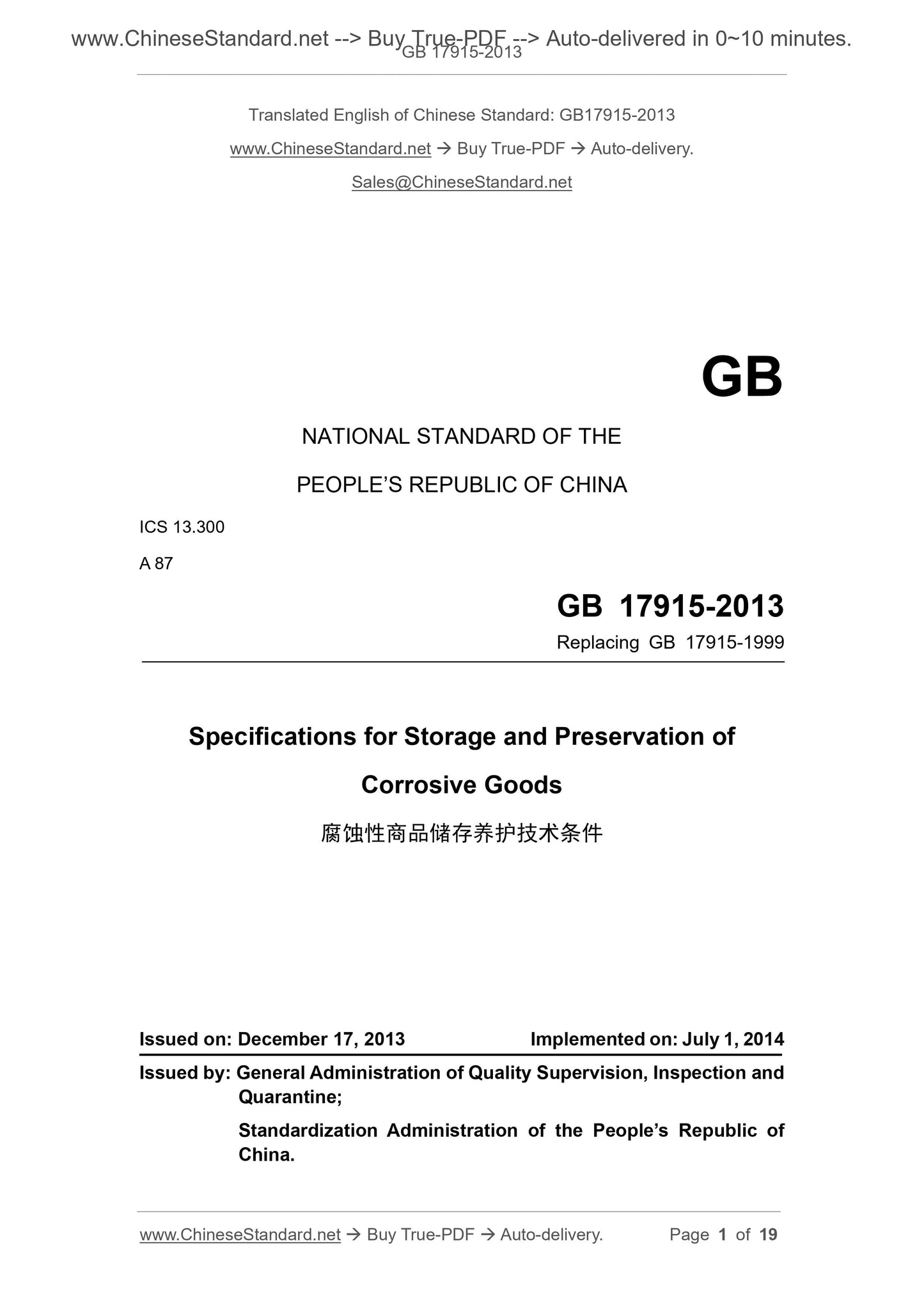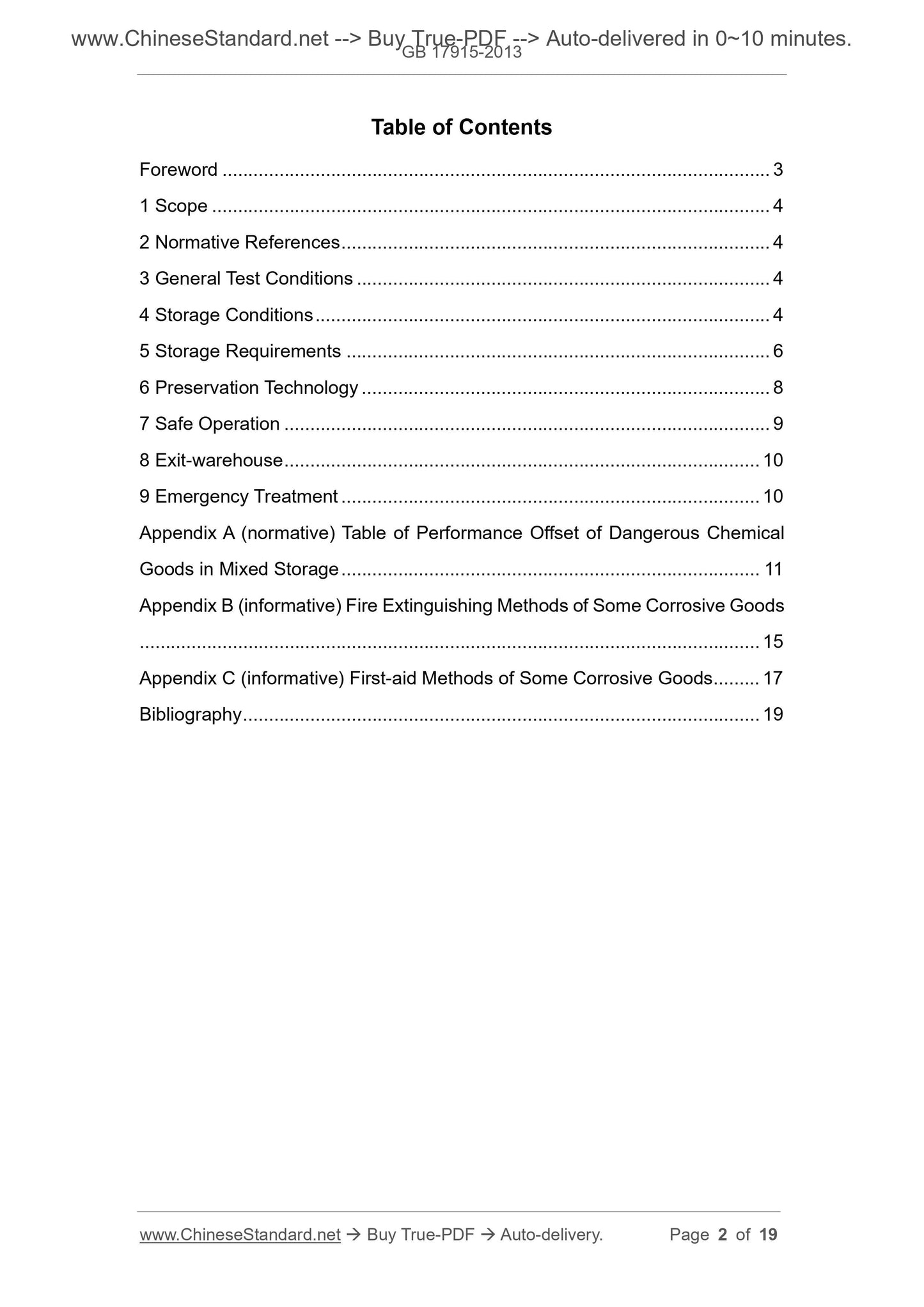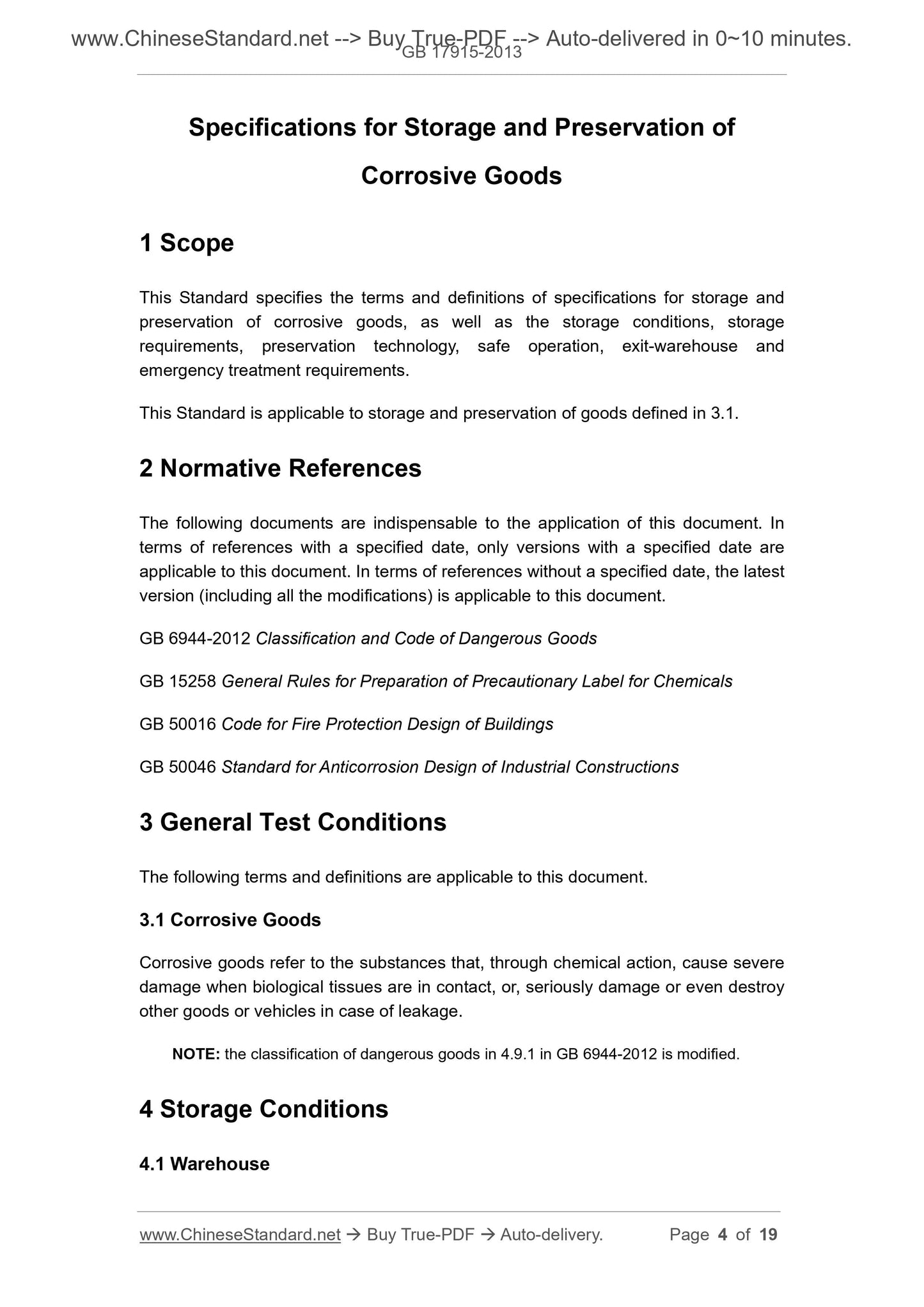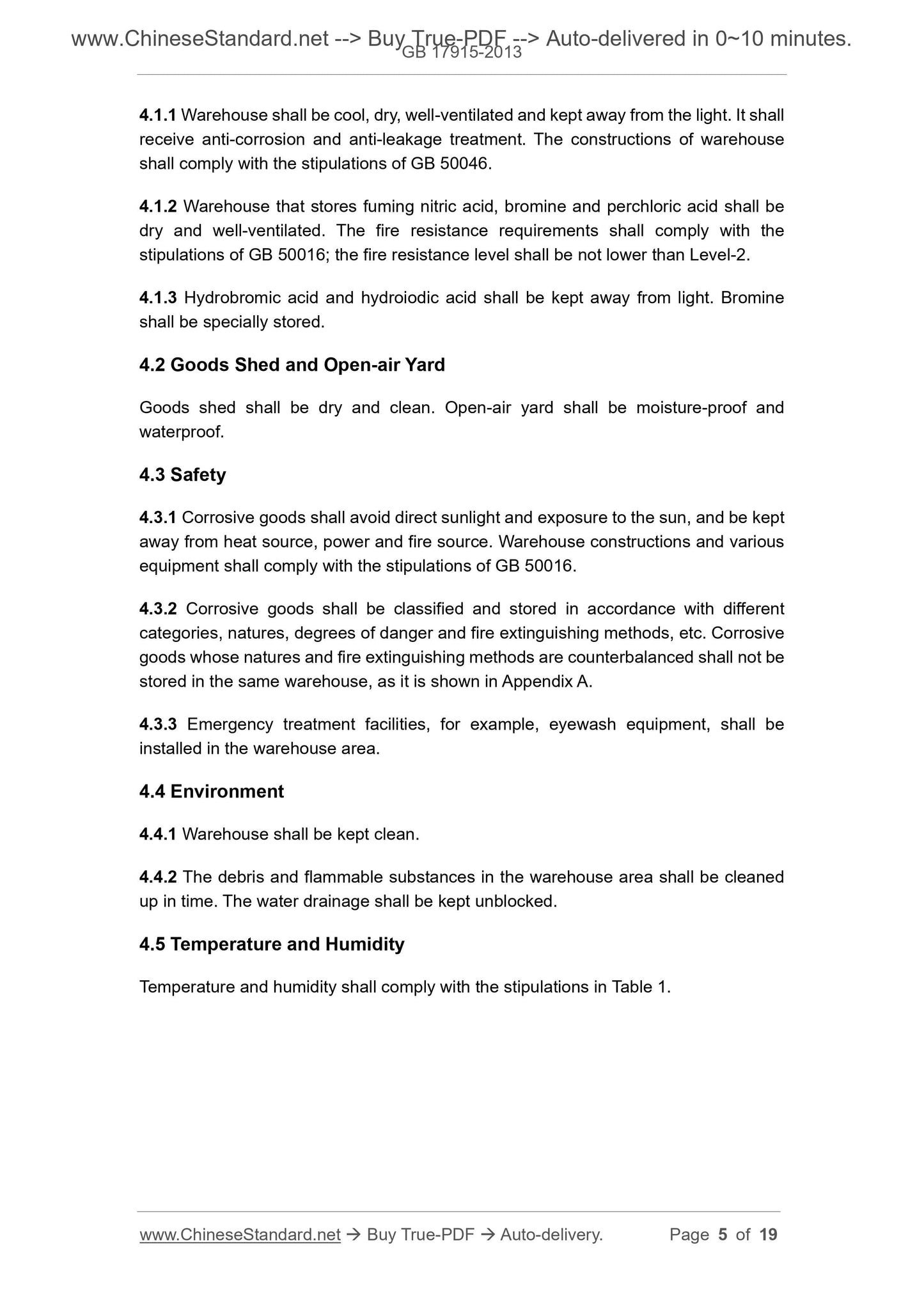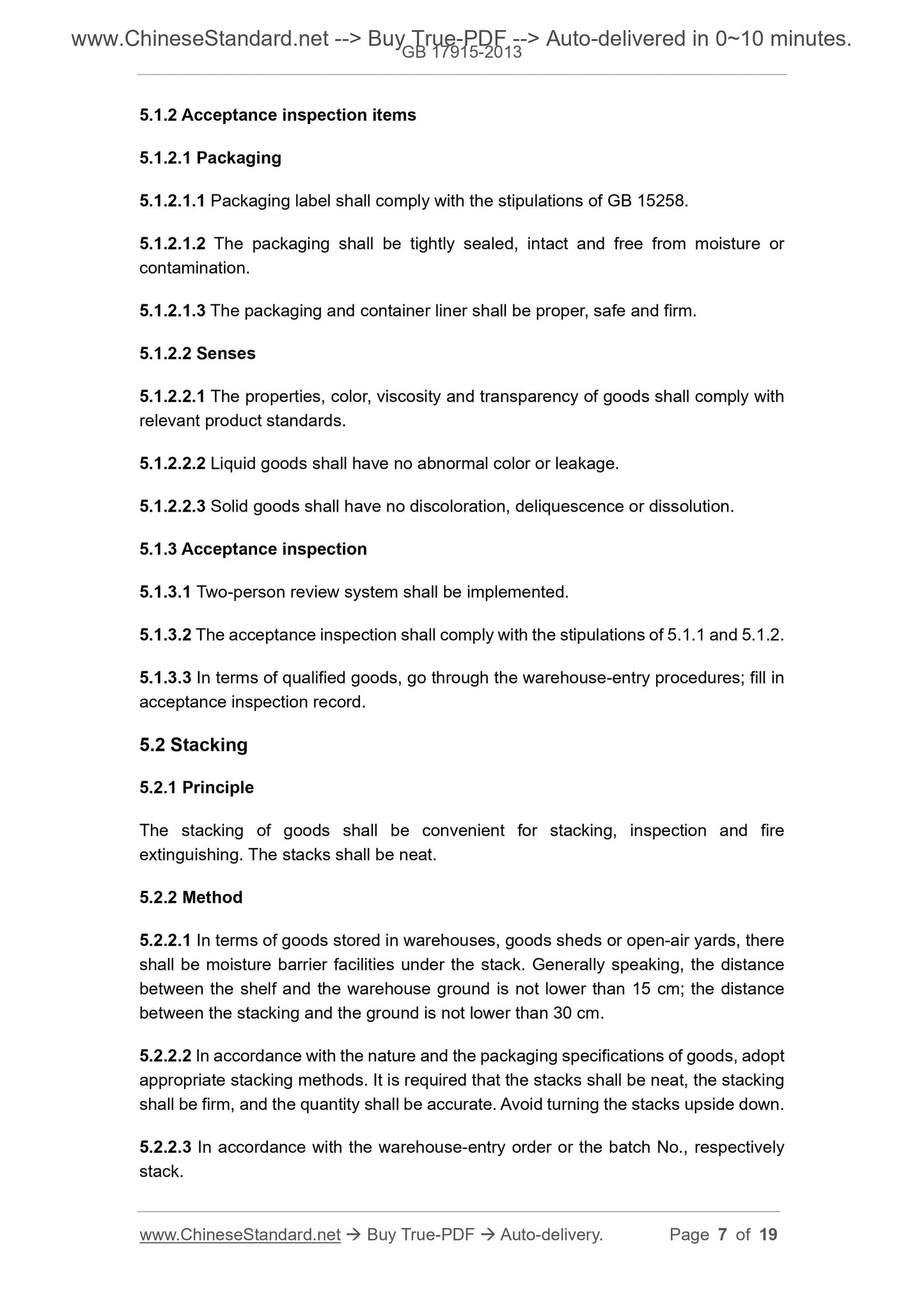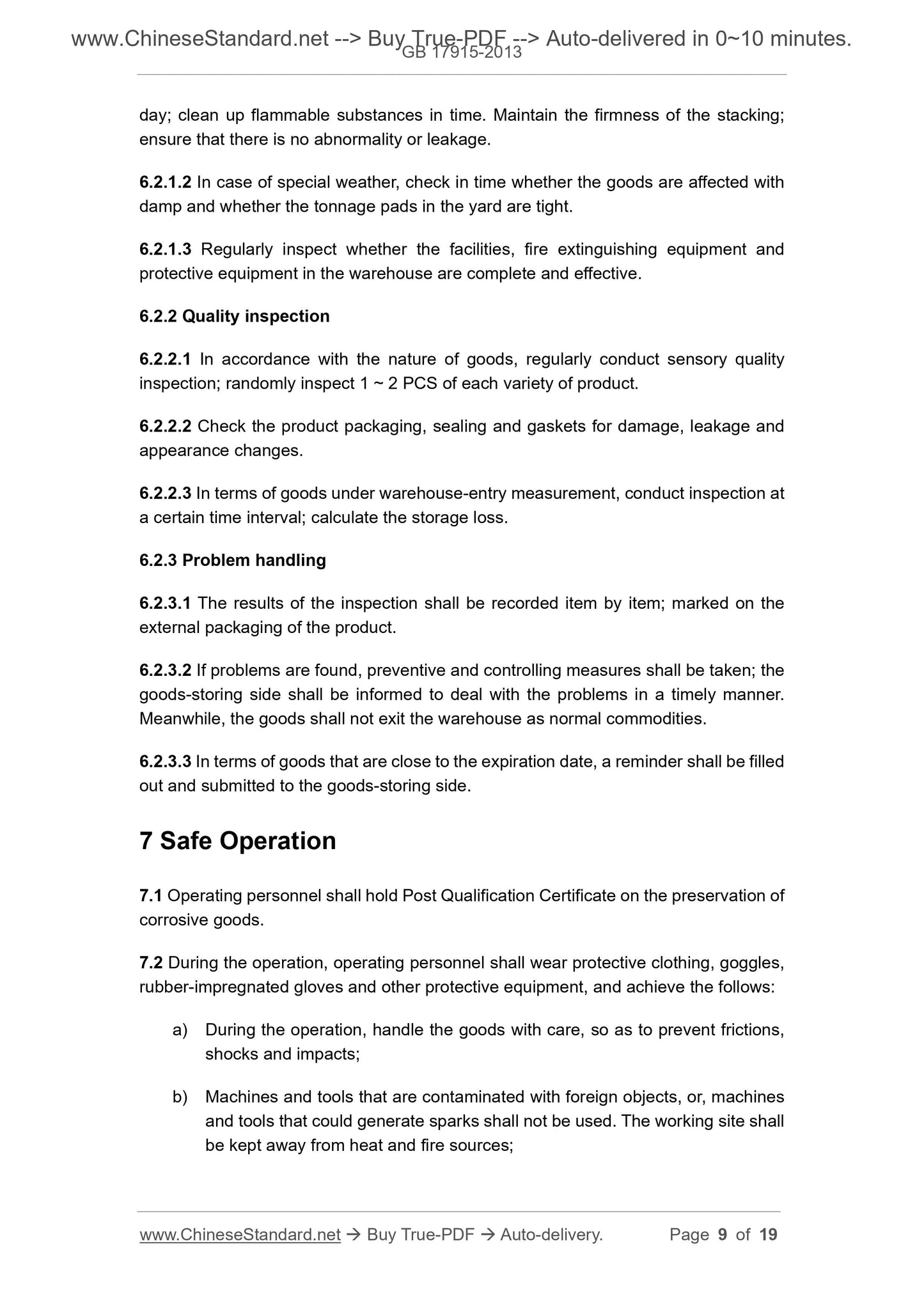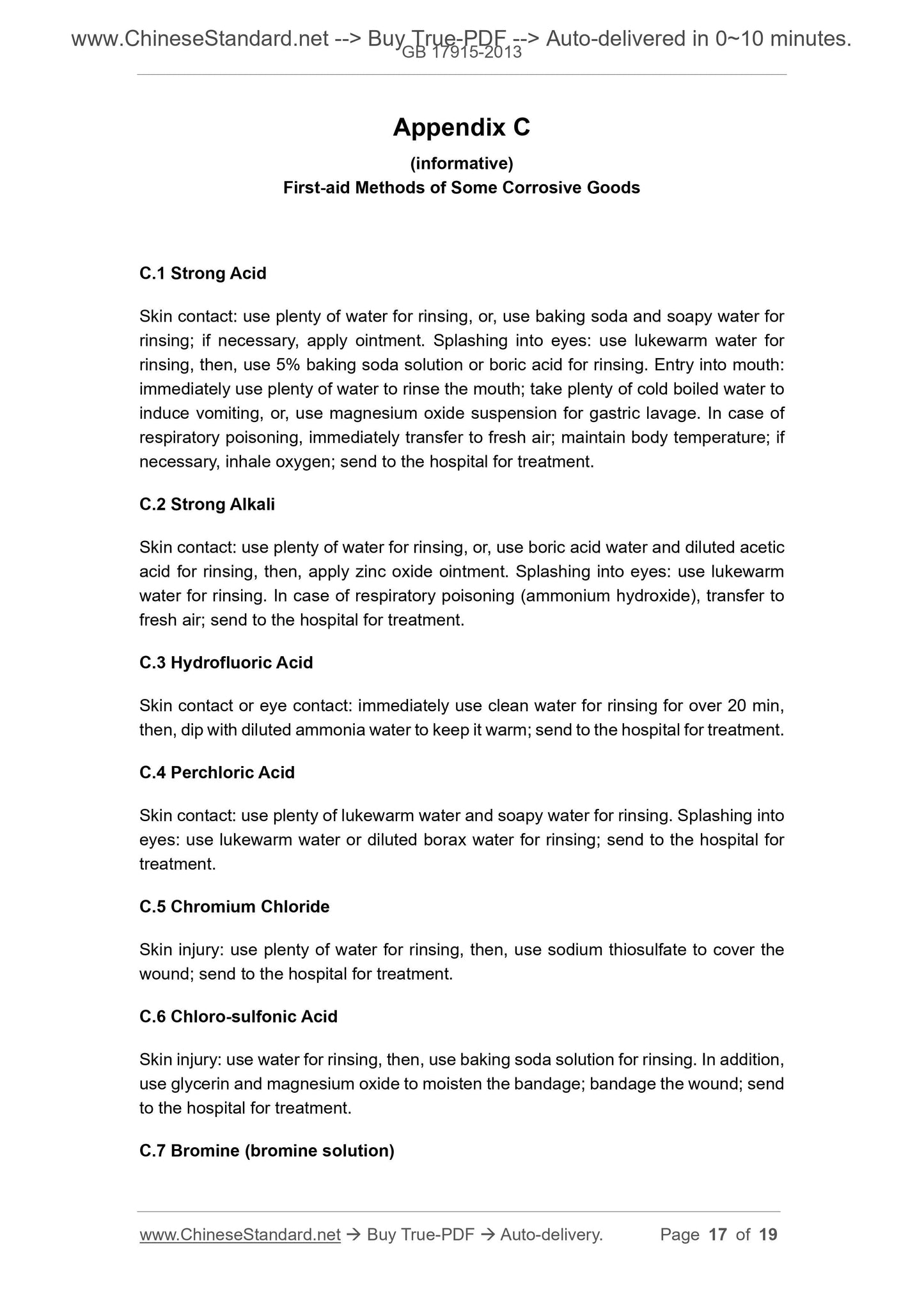1
/
dari
7
PayPal, credit cards. Download editable-PDF & invoice in 1 second!
GB 17915-2013 English PDF (GB17915-2013)
GB 17915-2013 English PDF (GB17915-2013)
Harga reguler
$155.00 USD
Harga reguler
Harga obral
$155.00 USD
Harga satuan
/
per
Biaya pengiriman dihitung saat checkout.
Tidak dapat memuat ketersediaan pengambilan
Delivery: 3 seconds. Download true-PDF + Invoice.
Get QUOTATION in 1-minute: Click GB 17915-2013
Historical versions: GB 17915-2013
Preview True-PDF (Reload/Scroll if blank)
GB 17915-2013: Specifications for storage and preservation of corrosive goods
GB 17915-2013
NATIONAL STANDARD OF THE
PEOPLE’S REPUBLIC OF CHINA
ICS 13.300
A 87
Replacing GB 17915-1999
Specifications for Storage and Preservation of
Corrosive Goods
ISSUED ON: DECEMBER 17, 2013
IMPLEMENTED ON: JULY 1, 2014
Issued by: General Administration of Quality Supervision, Inspection and
Quarantine;
Standardization Administration of the People’s Republic of
China.
Table of Contents
Foreword ... 3
1 Scope ... 4
2 Normative References ... 4
3 General Test Conditions ... 4
4 Storage Conditions ... 4
5 Storage Requirements ... 6
6 Preservation Technology ... 8
7 Safe Operation ... 9
8 Exit-warehouse ... 10
9 Emergency Treatment ... 10
Appendix A (normative) Table of Performance Offset of Dangerous Chemical
Goods in Mixed Storage ... 11
Appendix B (informative) Fire Extinguishing Methods of Some Corrosive Goods
... 15
Appendix C (informative) First-aid Methods of Some Corrosive Goods ... 17
Bibliography ... 19
Specifications for Storage and Preservation of
Corrosive Goods
1 Scope
This Standard specifies the terms and definitions of specifications for storage and
preservation of corrosive goods, as well as the storage conditions, storage
requirements, preservation technology, safe operation, exit-warehouse and
emergency treatment requirements.
This Standard is applicable to storage and preservation of goods defined in 3.1.
2 Normative References
The following documents are indispensable to the application of this document. In
terms of references with a specified date, only versions with a specified date are
applicable to this document. In terms of references without a specified date, the latest
version (including all the modifications) is applicable to this document.
GB 6944-2012 Classification and Code of Dangerous Goods
GB 15258 General Rules for Preparation of Precautionary Label for Chemicals
GB 50016 Code for Fire Protection Design of Buildings
GB 50046 Standard for Anticorrosion Design of Industrial Constructions
3 General Test Conditions
The following terms and definitions are applicable to this document.
3.1 Corrosive Goods
Corrosive goods refer to the substances that, through chemical action, cause severe
damage when biological tissues are in contact, or, seriously damage or even destroy
other goods or vehicles in case of leakage.
NOTE: the classification of dangerous goods in 4.9.1 in GB 6944-2012 is modified.
4 Storage Conditions
4.1 Warehouse
4.1.1 Warehouse shall be cool, dry, well-ventilated and kept away from the light. It shall
receive anti-corrosion and anti-leakage treatment. The constructions of warehouse
shall comply with the stipulations of GB 50046.
4.1.2 Warehouse that stores fuming nitric acid, bromine and perchloric acid shall be
dry and well-ventilated. The fire resistance requirements shall comply with the
stipulations of GB 50016; the fire resistance level shall be not lower than Level-2.
4.1.3 Hydrobromic acid and hydroiodic acid shall be kept away from light. Bromine
shall be specially stored.
4.2 Goods Shed and Open-air Yard
Goods shed shall be dry and clean. Open-air yard shall be moisture-proof and
waterproof.
4.3 Safety
4.3.1 Corrosive goods shall avoid direct sunlight and exposure to the sun, and be kept
away from heat source, power and fire source. Warehouse constructions and various
equipment shall comply with the stipulations of GB 50016.
4.3.2 Corrosive goods shall be classified and stored in accordance with different
categories, natures, degrees of danger and fire extinguishing methods, etc. Corrosive
goods whose natures and fire extinguishing methods are counterbalanced shall not be
stored in the same warehouse, as it is shown in Appendix A.
4.3.3 Emergency treatment facilities, for example, eyewash equipment, shall be
installed in the warehouse area.
4.4 Environment
4.4.1 Warehouse shall be kept clean.
4.4.2 The debris and flammable substances in the warehouse area shall be cleaned
up in time. The water drainage shall be kept unblocked.
4.5 Temperature and Humidity
Temperature and humidity shall comply with the stipulations in Table 1.
5.1.2 Acceptance inspection items
5.1.2.1 Packaging
5.1.2.1.1 Packaging label shall comply with the stipulations of GB 15258.
5.1.2.1.2 The packaging shall be tightly sealed, intact and free from moisture or
contamination.
5.1.2.1.3 The packaging and container liner shall be proper, safe and firm.
5.1.2.2 Senses
5.1.2.2.1 The properties, color, viscosity and transparency of goods shall comply with
relevant product standards.
5.1.2.2.2 Liquid goods shall have no abnormal color or leakage.
5.1.2.2.3 Solid goods shall have no discoloration, deliquescence or dissolution.
5.1.3 Acceptance inspection
5.1.3.1 Two-person review system shall be implemented.
5.1.3.2 The acceptance inspection shall comply with the stipulations of 5.1.1 and 5.1.2.
5.1.3.3 In terms of qualified goods, go through the warehouse-entry procedures; fill in
acceptance inspection record.
5.2 Stacking
5.2.1 Principle
The stacking of goods shall be convenient for stacking, inspection and fire
extinguishing. The stacks shall be neat.
5.2.2 Method
5.2.2.1 In terms of goods stored in warehouses, goods sheds or open-air yards, there
shall be moisture barrier facilities under the stack. Generally speaking, the distance
between the shelf and the warehouse ground is not lower than 15 cm; the distance
between the stacking and the ground is not lower than 30 cm.
5.2.2.2 In accordance with the nature and the packaging specifications of goods, adopt
appropriate stacking methods. It is required that the stacks shall be neat, the stacking
shall be firm, and the quantity shall be accurate. Avoid turning the stacks upside down.
5.2.2.3 In accordance with the warehouse-entry order or the batch No., respectively
stack.
day; clean up flammable substances in time. Maintain the firmness of the stacking;
ensure that there is no abnormality or leakage.
6.2.1.2 In case of special weather, check in time whether the goods are affected with
damp and whether the tonnage pads in the yard are tight.
6.2.1.3 Regularly inspect whether the facilities, fire extinguishing equipment and
protective equipment in the warehouse are complete and effective.
6.2.2 Quality inspection
6.2.2.1 In accordance with the nature of goods, regularly conduct sensory quality
inspection; randomly inspect 1 ~ 2 PCS of each variety of product.
6.2.2.2 Check the product packaging, sealing and gaskets for damage, leakage and
appearance changes.
6.2.2.3 In terms of goods under warehouse-entry measurement, conduct inspection at
a certain time interval; calculate the storage loss.
6.2.3 Problem handling
6.2.3.1 The results of the inspection shall be recorded item by item; marked on the
external packaging of the product.
6.2.3.2 If problems are found, preventive and controlling measures shall be taken; the
goods-storing side shall be informed to deal with the problems in a timely manner.
Meanwhile, the goods shall not exit the warehouse as normal commodities.
6.2.3.3 In terms of goods that are close to the expiration date, a reminder shall be filled
out and submitted to the goods-storing side.
7 Safe Operation
7.1 Operating personnel shall hold Post Qualification Certificate on the preservation of
corrosive goods.
7.2 During the operation, operating personnel shall wear protective...
Get QUOTATION in 1-minute: Click GB 17915-2013
Historical versions: GB 17915-2013
Preview True-PDF (Reload/Scroll if blank)
GB 17915-2013: Specifications for storage and preservation of corrosive goods
GB 17915-2013
NATIONAL STANDARD OF THE
PEOPLE’S REPUBLIC OF CHINA
ICS 13.300
A 87
Replacing GB 17915-1999
Specifications for Storage and Preservation of
Corrosive Goods
ISSUED ON: DECEMBER 17, 2013
IMPLEMENTED ON: JULY 1, 2014
Issued by: General Administration of Quality Supervision, Inspection and
Quarantine;
Standardization Administration of the People’s Republic of
China.
Table of Contents
Foreword ... 3
1 Scope ... 4
2 Normative References ... 4
3 General Test Conditions ... 4
4 Storage Conditions ... 4
5 Storage Requirements ... 6
6 Preservation Technology ... 8
7 Safe Operation ... 9
8 Exit-warehouse ... 10
9 Emergency Treatment ... 10
Appendix A (normative) Table of Performance Offset of Dangerous Chemical
Goods in Mixed Storage ... 11
Appendix B (informative) Fire Extinguishing Methods of Some Corrosive Goods
... 15
Appendix C (informative) First-aid Methods of Some Corrosive Goods ... 17
Bibliography ... 19
Specifications for Storage and Preservation of
Corrosive Goods
1 Scope
This Standard specifies the terms and definitions of specifications for storage and
preservation of corrosive goods, as well as the storage conditions, storage
requirements, preservation technology, safe operation, exit-warehouse and
emergency treatment requirements.
This Standard is applicable to storage and preservation of goods defined in 3.1.
2 Normative References
The following documents are indispensable to the application of this document. In
terms of references with a specified date, only versions with a specified date are
applicable to this document. In terms of references without a specified date, the latest
version (including all the modifications) is applicable to this document.
GB 6944-2012 Classification and Code of Dangerous Goods
GB 15258 General Rules for Preparation of Precautionary Label for Chemicals
GB 50016 Code for Fire Protection Design of Buildings
GB 50046 Standard for Anticorrosion Design of Industrial Constructions
3 General Test Conditions
The following terms and definitions are applicable to this document.
3.1 Corrosive Goods
Corrosive goods refer to the substances that, through chemical action, cause severe
damage when biological tissues are in contact, or, seriously damage or even destroy
other goods or vehicles in case of leakage.
NOTE: the classification of dangerous goods in 4.9.1 in GB 6944-2012 is modified.
4 Storage Conditions
4.1 Warehouse
4.1.1 Warehouse shall be cool, dry, well-ventilated and kept away from the light. It shall
receive anti-corrosion and anti-leakage treatment. The constructions of warehouse
shall comply with the stipulations of GB 50046.
4.1.2 Warehouse that stores fuming nitric acid, bromine and perchloric acid shall be
dry and well-ventilated. The fire resistance requirements shall comply with the
stipulations of GB 50016; the fire resistance level shall be not lower than Level-2.
4.1.3 Hydrobromic acid and hydroiodic acid shall be kept away from light. Bromine
shall be specially stored.
4.2 Goods Shed and Open-air Yard
Goods shed shall be dry and clean. Open-air yard shall be moisture-proof and
waterproof.
4.3 Safety
4.3.1 Corrosive goods shall avoid direct sunlight and exposure to the sun, and be kept
away from heat source, power and fire source. Warehouse constructions and various
equipment shall comply with the stipulations of GB 50016.
4.3.2 Corrosive goods shall be classified and stored in accordance with different
categories, natures, degrees of danger and fire extinguishing methods, etc. Corrosive
goods whose natures and fire extinguishing methods are counterbalanced shall not be
stored in the same warehouse, as it is shown in Appendix A.
4.3.3 Emergency treatment facilities, for example, eyewash equipment, shall be
installed in the warehouse area.
4.4 Environment
4.4.1 Warehouse shall be kept clean.
4.4.2 The debris and flammable substances in the warehouse area shall be cleaned
up in time. The water drainage shall be kept unblocked.
4.5 Temperature and Humidity
Temperature and humidity shall comply with the stipulations in Table 1.
5.1.2 Acceptance inspection items
5.1.2.1 Packaging
5.1.2.1.1 Packaging label shall comply with the stipulations of GB 15258.
5.1.2.1.2 The packaging shall be tightly sealed, intact and free from moisture or
contamination.
5.1.2.1.3 The packaging and container liner shall be proper, safe and firm.
5.1.2.2 Senses
5.1.2.2.1 The properties, color, viscosity and transparency of goods shall comply with
relevant product standards.
5.1.2.2.2 Liquid goods shall have no abnormal color or leakage.
5.1.2.2.3 Solid goods shall have no discoloration, deliquescence or dissolution.
5.1.3 Acceptance inspection
5.1.3.1 Two-person review system shall be implemented.
5.1.3.2 The acceptance inspection shall comply with the stipulations of 5.1.1 and 5.1.2.
5.1.3.3 In terms of qualified goods, go through the warehouse-entry procedures; fill in
acceptance inspection record.
5.2 Stacking
5.2.1 Principle
The stacking of goods shall be convenient for stacking, inspection and fire
extinguishing. The stacks shall be neat.
5.2.2 Method
5.2.2.1 In terms of goods stored in warehouses, goods sheds or open-air yards, there
shall be moisture barrier facilities under the stack. Generally speaking, the distance
between the shelf and the warehouse ground is not lower than 15 cm; the distance
between the stacking and the ground is not lower than 30 cm.
5.2.2.2 In accordance with the nature and the packaging specifications of goods, adopt
appropriate stacking methods. It is required that the stacks shall be neat, the stacking
shall be firm, and the quantity shall be accurate. Avoid turning the stacks upside down.
5.2.2.3 In accordance with the warehouse-entry order or the batch No., respectively
stack.
day; clean up flammable substances in time. Maintain the firmness of the stacking;
ensure that there is no abnormality or leakage.
6.2.1.2 In case of special weather, check in time whether the goods are affected with
damp and whether the tonnage pads in the yard are tight.
6.2.1.3 Regularly inspect whether the facilities, fire extinguishing equipment and
protective equipment in the warehouse are complete and effective.
6.2.2 Quality inspection
6.2.2.1 In accordance with the nature of goods, regularly conduct sensory quality
inspection; randomly inspect 1 ~ 2 PCS of each variety of product.
6.2.2.2 Check the product packaging, sealing and gaskets for damage, leakage and
appearance changes.
6.2.2.3 In terms of goods under warehouse-entry measurement, conduct inspection at
a certain time interval; calculate the storage loss.
6.2.3 Problem handling
6.2.3.1 The results of the inspection shall be recorded item by item; marked on the
external packaging of the product.
6.2.3.2 If problems are found, preventive and controlling measures shall be taken; the
goods-storing side shall be informed to deal with the problems in a timely manner.
Meanwhile, the goods shall not exit the warehouse as normal commodities.
6.2.3.3 In terms of goods that are close to the expiration date, a reminder shall be filled
out and submitted to the goods-storing side.
7 Safe Operation
7.1 Operating personnel shall hold Post Qualification Certificate on the preservation of
corrosive goods.
7.2 During the operation, operating personnel shall wear protective...
Share
